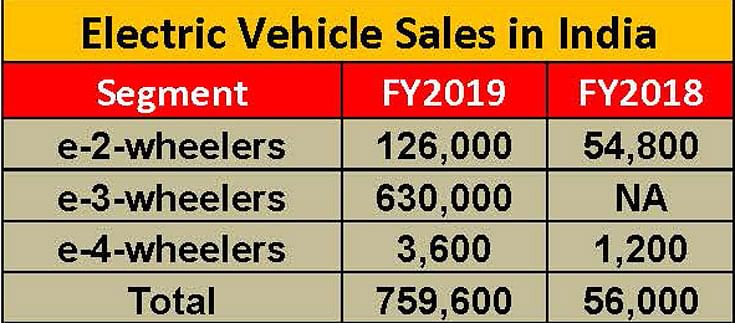EV sales in India cross 750,000 units in FY2019 but FAME II may spoil the run
Lack of incentives in the FAME II policy for private EV buyers, a heavy thrust on localisation and low volumes for Lithium-ion battery products are a cause of concern for the industry.
For India Auto Inc, FY2019 may have been a dampener for overall internal combustion-engined vehicle sales, given that they recorded single-digit growth. In comparison, albeit on a much lower base, the country’s nascent electric vehicle (EV) industry notched handsome numbers but the green vehicle segment may not have reason to celebrate in the future. Here’s why.
In FY2019, total EV sales in India crossed the 750,000 unit mark to total 759,600 units (see sales table below). This includes electric two-wheelers (126,000), electric three-wheelers (630,000) and electric passenger vehicles (3,600), which translates into electric two-wheelers witnessing triple-digit growth (130%) YoY. Interestingly, while the FY2019 statistics reveal a significant year-on-year jump, the ground reality after the government's announcement of the much-awaited FAME II (Faster Adoption and Manufacturing of Electric Vehicles) scheme in early April looks to be quite shocking.
SMEV calls for tweaking of FAME II policy
Speaking to Autocar Professional, Sohinder Singh Gill, director general, Society of Manufacturers of Electric Vehicles (SMEV) and CEO, Hero Electric, explaining the ups and downs of FY2019, says: "The positive is that we are learning to stand on our own feet, without any government support. And the negative is that sales in April 2019 have been totally wiped off."
Elaborating on the reason behind the drop in sales is that none of the EVs sold in the country at present are able to meet the new criteria outlined by the Department of Heavy Industries (DHI) under the recently announced second phase of the FAME (. In addition, there is also a re-certification process that resulted in EVs having to undergo the entire process of CMVR Rules, which takes around 30 to 45 days of re-testing and has resulted in many vehicles awaiting certification.
Sharing his concerns, Gill says, "If it (ground reality) continues the way it is, the ambition of achieving sales of over 1 million EVs in India in the next few years looks bleak. We won't even be able to achieve 50 percent of the expected target."
He adds that if the situation is not addressed with corrective measures and supportive policies, the industry may see dumping of cheap, unreliable products by companies looking to make a quick buck.
OEMs and customers doing a rethink on expensive Li-ion?
According to SMEV, if electric vehicle sales in India have to pick up, a realistic approach with supportive policies will be needed, or else EVs would continue to remain a niche product. Gill says a lithium-ion battery-powered e-two-wheeler, to get incentives under the FAME II policy, is expected to have a range of around 80km per charge, which means that it will need to have an at least 2kw battery that costs around Rs 50,000. This means, for the customer to replace or buy a battery, would be equivalent of buying a new entry level two-wheeler.
The EV body feels that if the unfavourable circumstances prevail, electric two-wheeler customers and OEMs will be compelled to go back to using lead-acid battery based products, as they cost almost half of what a similar lithium-ion battery powered vehicle costs and that too after deducting the FAME II subsidy. Meanwhile, the e-three-wheeler industry has been growing without government support and would continue to do so.
As regards electric cars in India, at present only two OEMs — Mahindra Electric and Tata Motors — have heavily invested in the EV industry. The lack of incentives for private buyers in FAME II and the high initial cost of an electric car are already dampeners for OEMs to introduce new models and justify their investments. This could lead to global OEMs bringing in base models through the CBU or CKD route and selling a few hundred units as the industry volumes will continue to remain low.
What’s clear is that if the EV industry is expected to clock higher sales and the country to see higher EV adoption, the ambitious FAME II scheme needs to be aggressively tweaked, keeping in mind all the stakeholders and ground realities in mind.

Also read: Definitions and criteria for EV vehicles in FAME II
FAME II good but not enough, says India Auto Inc at Two-Wheeler Industry Conclave
Tork Motors urges government to increase FAME II electric 2W incentive limit
Heavy Industry Ministry scouts for 'Knowledge Partner' to promote FAME II
RELATED ARTICLES
VinFast’s second plant in Vietnam goes on stream ahead of India factory
Vietnamese EV maker’s second plant in its home market, which has a 200,000 EVs-per-annum capacity, will focus on produci...
Continental exits TBR market in India, shifts focus to car and SUV radials
German tyre manufacturer aims to tap the double-digit market growth opportunity for big SUV and luxury car tyres which w...
New ZF SELECT e-drive platform gives EV makers a choice in 100 to 300 kW range
Modular e-drive platform optimally matches 800-volt overall system and components such as the electric motor and power e...





 30 Apr 2019
30 Apr 2019
 26177 Views
26177 Views





 Autocar Professional Bureau
Autocar Professional Bureau




